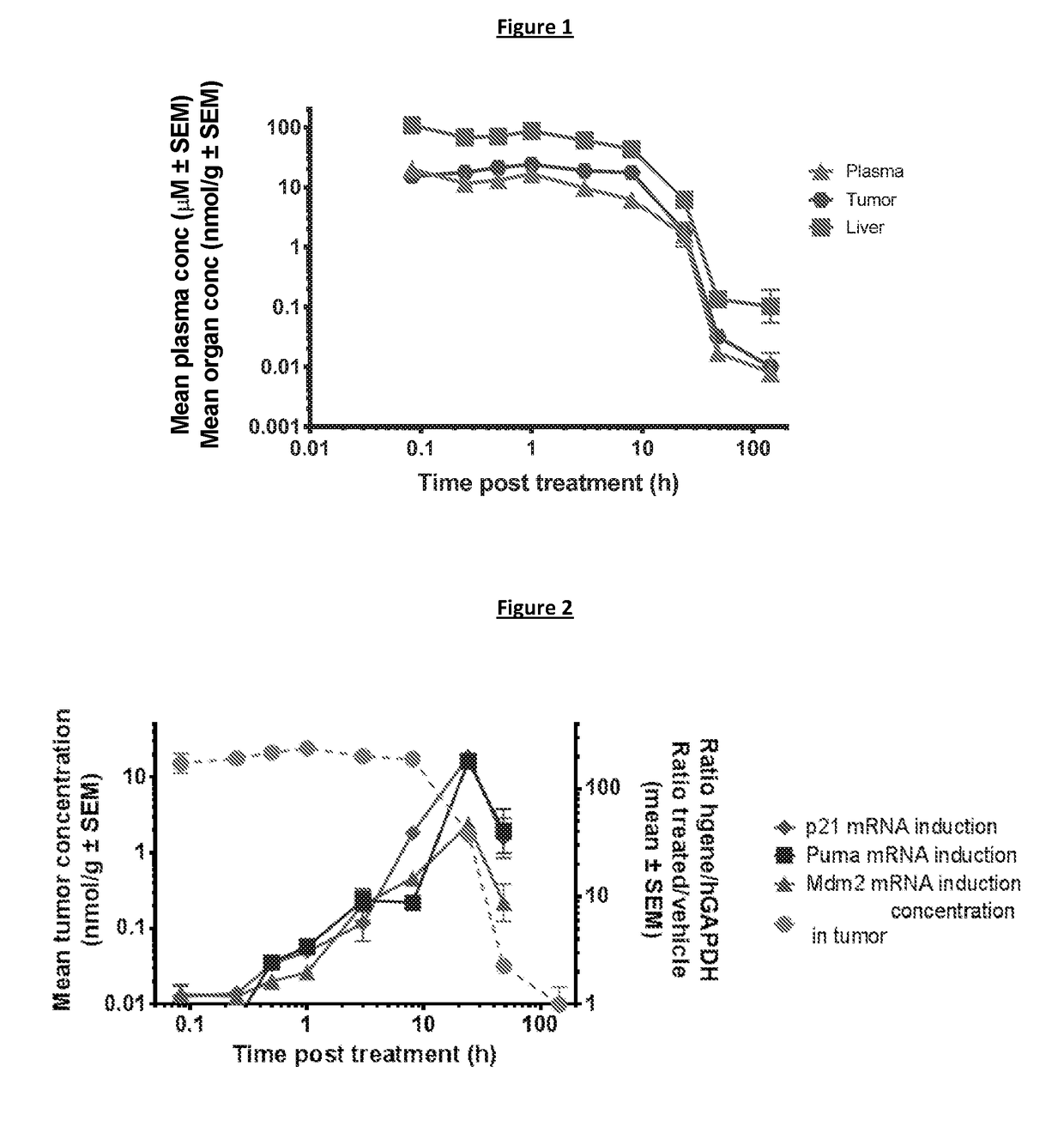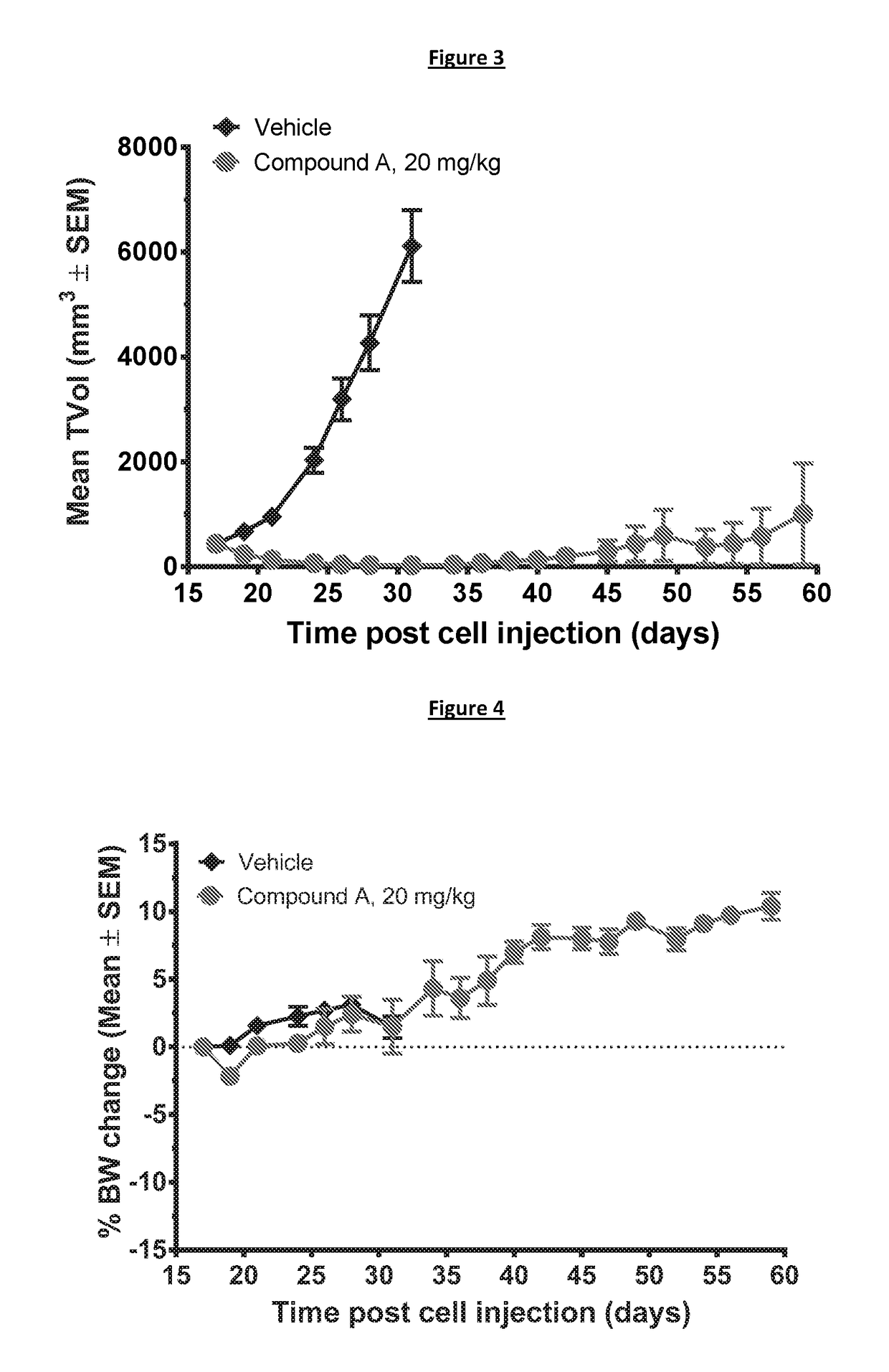Intermittent dosing of mdm2 inhibitor
a technology of mdm2 inhibitor and inhibitor, which is applied in the direction of heterocyclic compound active ingredients, drug compositions, organic active ingredients, etc., can solve the problems of substantial tumor shrinkage, achieve high synergistic effect, improve efficacy, and increase tolerability
- Summary
- Abstract
- Description
- Claims
- Application Information
AI Technical Summary
Benefits of technology
Problems solved by technology
Method used
Image
Examples
example 1
Pharmacokinetics (PK) of Compound A after Single i.v. Injection at 20 mg / kg
[0148]FIG. 1 shows Compound A concentration in plasma, tumor and liver over 144 hours after one single i.v. injection. The Tmax for the compound was 5 min in plasma and liver and 1 h in tumor. Compound A had a two times higher exposure in tumor (AUC0-144h dn=16.5 h.nmol / g) compared to plasma (AUC0-144h dn=8.1 h.μM). FIG. 2 shows the Compound A concentration in tumor and the pharmacodynamics (PD) response in tumor. Puma and p21 had a very similar mRNA induction reaching an expression max of 180 and 200-fold 24 h post treatment, respectively.
example 2
PK, PD, Efficacy and Tolerability of Compound A (i.v., once) on SJSA-1 Tumor-Bearing Rat
[0149]FIGS. 3 and 4, respectively show the tumor growth and the change in body weight of nude rats over 42 days. The single i.v. treatment with compound A at 20 mg / kg (the higher dose) induced 92% tumor regression 14 days post treatment. One rat had to be sacrificed on day 9 post treatment because of excessive body weight (BW) loss. In spite of a slight decrease in BW 3 days post treatment for all others rats, they recovered quickly and gained BW during the entire experiment. Only 2 of 11 tumors had an incomplete response and regrew (FIG. 5). These 2 animals were retreated i.v. at 15 mg / kg and the tumors were still sensitive. However, tumor regression was attenuated which could be due to the larger tumor size. After the first treatment, p21 and Puma mRNA expression in tumor reached a more than 50-fold increase in mRNA expression. Mdm2 had a much lower mRNA induction (Emax=10-fold). On day 59 post...
example 3
PK, PD, Efficacy and Tolerability of Compound A (i.v., q3w) on SJSA-1 Tumor-Bearing Rat
[0150]FIG. 8 shows the tumor growth and the change in body weight of nude rats over 42 days. Three weeks post first treatment at 20 mg / kg, compound A induced 6% tumor regression on average. However, individual data show that 3 rats had complete response (100% regression), 2 had partial response (more than 50% regression), 1 had stable disease and 1 had progressive disease in spite of an early 80% regression 1 week post treatment. After the second treatment, Compound A induced 100% tumor regression but only 2 / 7 animals survived the 2 full cycles. Indeed, 5 rats had to be sacrificed after the second treatment because of excessive BW loss: the first one 10 days post second treatment and the four others 8 days later. FIG. 9 shows the white blood cells (WBC), neutrophils and platelets count over the 42 days of experiment. Compound A induced a dramatic decrease in WBCs, neutrophils and platelets after t...
PUM
| Property | Measurement | Unit |
|---|---|---|
| Time | aaaaa | aaaaa |
| Time | aaaaa | aaaaa |
| Time | aaaaa | aaaaa |
Abstract
Description
Claims
Application Information
 Login to View More
Login to View More - R&D
- Intellectual Property
- Life Sciences
- Materials
- Tech Scout
- Unparalleled Data Quality
- Higher Quality Content
- 60% Fewer Hallucinations
Browse by: Latest US Patents, China's latest patents, Technical Efficacy Thesaurus, Application Domain, Technology Topic, Popular Technical Reports.
© 2025 PatSnap. All rights reserved.Legal|Privacy policy|Modern Slavery Act Transparency Statement|Sitemap|About US| Contact US: help@patsnap.com



